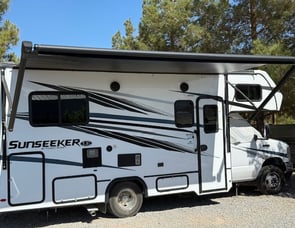Death Valley National Park

WIDE-RANGING INVENTORY
From affordable pop-ups to luxury motorhomesLARGEST RV RENTAL MARKETPLACE
Thousands of 5 star reviews from happy customersSECURE AND MOST TRUSTED
24/7 Emergency roadside assistance on every booking- Home
- National Parks
- Death Valley National Park
This RV guide to Death Valley National Park illustrates the unique extremes that make up Death Valley but that also make it a place worth visiting in an RV. Because of Death Valley's remoteness, the RV rental options start at about 50 miles away in Lone Pine, CA. About 70 miles away, you'll find Ridgecrest, CA, and 127 miles to the east, there's Las Vegas, NV. All of these are good places to find RV rentals near Death Valley National Park.
Discover Death Valley National Park in a video here.
Death Valley itself contains dozens of places of interest, all of which are accessible by vehicle. The only thing is that you might have to bring an off-roading vehicle with high ground clearance to reach them. Zabriskie Point is one of the most popular locations near the visitor center in Furnace Creek, which is usually open 8:00 a.m. until 5:00 p.m. daily. RVers love to photograph the salt flats and badlands. Speaking of badlands, Badwater Basin's stark magnificence as the lowest point in North America is just as popular. Further afield, you can travel to see Ubehebe Crater, which is a maar. It's important to note that even though you can find RV parking in Death Valley National Park, even here at the crater, the area is sacred to the Timbisha Shoshone First Nation and should be treated with utmost respect.
The maximum RV length for the campgrounds within Death Valley National Park are:
Furnace Creek Campground: 100 feet
Wildrose Campground: 25 feet
Texas Springs Campground: 35 feet
Mesquite Springs Campground: 35 feet
Sunset Campground: Unlimited
Stovepipe Wells Campground: Unlimited
You can only drive your RV over the paved roads and selected unpaved roads. Several campgrounds not on the above list require high ground clearance and all-wheel drive off-road vehicles to reach. You need either a weeklong pass or annual pass to enter Death Valley National Park. Most of the points of interest have parking lots that can accommodate your RV rental. Check out park conditions and/or road closures before setting out to Death Valley National Park. Route 190 runs through the center of the entire park, so you can enter from either end. Other entrances include Wildrose Road, Harry Wade Road, and Big Pine Road.
- Spring 82-99 F
- Summer 111-122 F
- Fall 95-106 F
- Winter 39-77 F
- Coming soon
- Death Valley National Park Private Vehicle: $30
- Death Valley National Park Motorcycle: $25
- Death Valley National Park Per Person: $15
- Death Valley National Park Annual Pass: $55
RV Rentals Near Death Valley National Park
Nearby RV Rentals
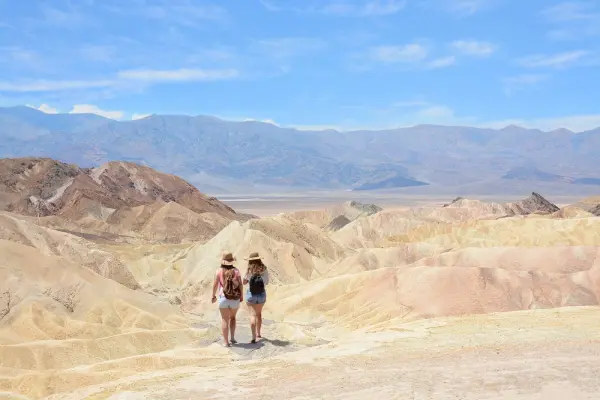
Death Valley National Park Hiking Trails
You'll find 108 blazed hiking trails in Death Valley National Park. You must be prepared for hiking in the extreme heat of the desert. If you hike in the evening or at night, then you must also be prepared for the cold of the desert night. Also, avoid hiking in low-lying areas during the hottest parts of the day. Always bring more water than you think you'll need. The absolute minimum for hiking would be two gallons of water per person per hour of hiking. Always let someone else know when you'll be leaving and planning to return. Carry a compass and, if possible, a solar-powered GPS device. Bring the strongest sunblock available along with wide-brim hats, dark sunglasses, and loose clothing. Extra socks are also a good idea, and so is foot powder. Death Valley National Park offers some of the best stargazing in the country at Class 1 on the Bortle Scale, so pack your telescope if you plan to hike at night.
Death Valley National Park Trails
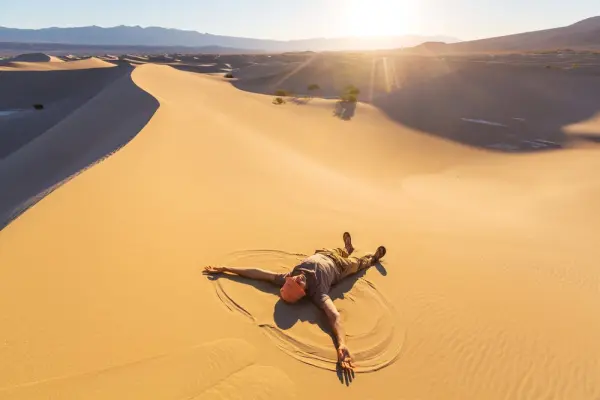
Things to do Outside Death Valley National Park
Despite the fact that the entire area is a remote desert, you can enjoy excellent food, exciting sightseeing, and quirky shopping both in the park and nearby.
Discover Nearby Towns and Cities
RV Resorts & Campsites near Death Valley National Park
Because of the popularity when it comes to RVing to Death Valley National Park, it's generally a good idea to make reservations as early as possible. The seasonal campgrounds are open from October to May instead of the other way around. Furnace Creek Campground is open year-round, but it takes reservations October 15 through April 15. The average cost of the campgrounds within Death Valley National Park is between $14 and $30 per night. A couple of the dispersed campgrounds are free of charge, and if you have an all-wheel-drive vehicle with the right ground clearance in addition to your RV, then you can visit those campgrounds, too. The cost at the Shoshone RV Park averages $50 a night. The closest Bureau of Land Management campground is Tuttle Creek Campground in Lone Pine, CA. It costs $10 a night.
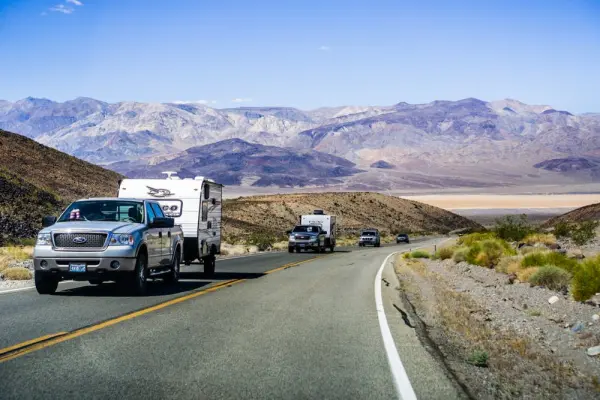
Campgrounds Near Death Valley National Park
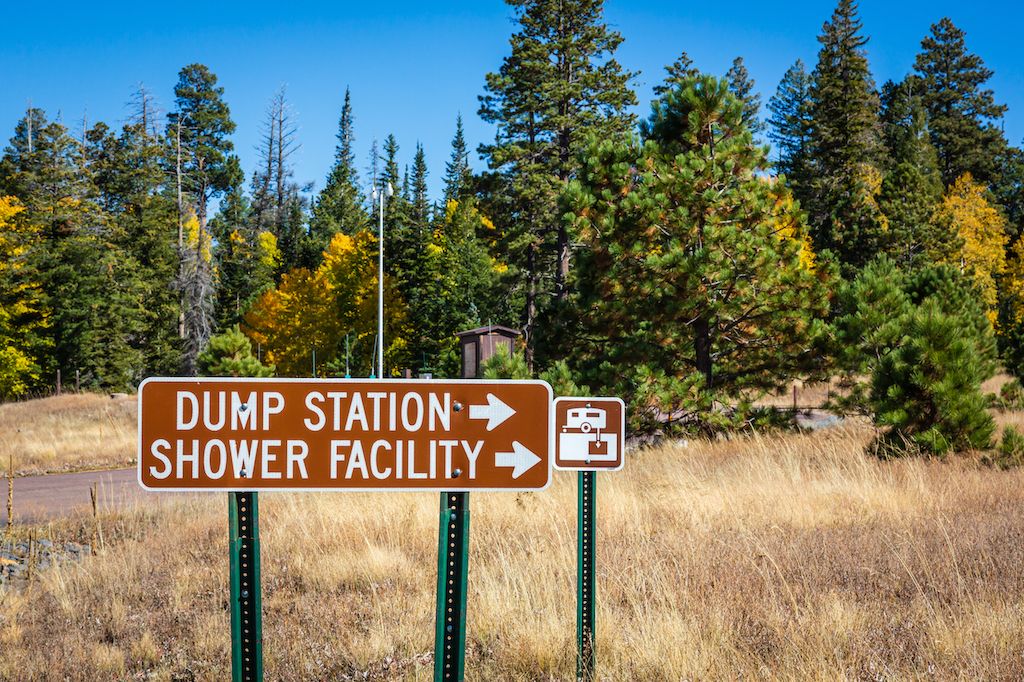
Find the Best Dumpstations Near Death Valley National Park
Dumpstations Near Death Valley National Park
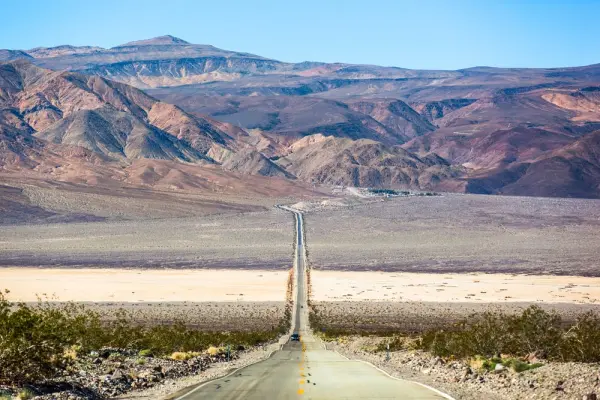
How to get to Death Valley National Park
The nearest major airport is Harry Reid International Airport in Las Vegas. For driving to Death Valley National Park from there, travel west out of the city on Route 160. Turn west on Bell Vista Avenue in Pahrump. Bell Vista Avenue eventually becomes Bell Vista Road and then Route 190. Follow Route 190 to Death Valley Junction, and turn north on Route 127. A short distance later, turn west on Route 190 again, and follow that to Furnace Creek.

Frequently Asked Questions
Spring is the best time of year to visit Death Valley National Park. Temperatures in the park are warm, but don't hit the scorching heat of summer. In the spring after a rainy winter, desert wildflowers bloom and make a beautiful landscape.
Death Valley National Park is 5,270 mi square miles, or 3,422,024 acres. This makes it the largest national park outside of Alaska. 93% of the park is officially designated wilderness, and the terrain ranges from salt flats to mountains with snow to sand dunes to oases.
Top things to do at Death Valley National Park include a visit to Badwater Basin, the lowest point in the Western hemisphere at 277 feet below sea level. Take Artist's Drive to see Artist's Palette and marvel at the multi-colored rocks. Also, check out the Racetrack, the sand dunes near Stovepipe Wells, and Ubehebe Crater among other sights.
Yes, pets are allowed at Death Valley National Park but there are limits to where they can be. Pets can be on roads, in campgrounds, in picnic areas, and in other developed areas of the park. They are not allowed on trails. Death Valley can get extremely hot and pets can not be left unattended in cars for their own safety.
Yes, there are designated camping spots at Death Valley National Park. Both Furnace Creek and Stovepipe Wells have RV hookup sites available, although they book up quickly. RVs under 25 feet long can camp at Mahogany Flats, Thorndike, and Wildrose Campgrounds. Some campgrounds are only open from fall to late spring and close during the extreme heat of summer.
Related
BLM Camping In Big Dune RV Rentals Near Ryan Campground BLM Camping In Ibex Wilderness BLM Camping In Amargosa Canyon BLM Camping In Manly Peak Wilderness RV Rentals Near Furnace Creek Campground BLM Camping In Nopah Range Wilderness BLM Camping In Darwin Falls Wilderness BLM Camping In Horsethief Springs/cabin BLM Camping In Coso Range Wilderness Area BLM Camping In Nopah Range Wilderness Area BLM Camping In Funeral Mountains Wilderness BLM Camping In South Nopah Range Wilderness Area BLM Camping In Funeral Mountains Wilderness Area RV Rentals Near Tecopa Hot Springs Campground & Pools
